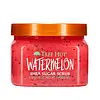What's inside
What's inside
 Key Ingredients
Key Ingredients

 Benefits
Benefits

 Concerns
Concerns

 Ingredients Side-by-side
Ingredients Side-by-side

Sucrose
HumectantGlycerin
HumectantPolysorbate 20
EmulsifyingSilica
AbrasiveActinidia Chinensis Seed
AbrasivePersea Gratissima Oil
Skin ConditioningButyrospermum Parkii Butter
Skin ConditioningCarthamus Tinctorius Seed Oil
MaskingPrunus Amygdalus Dulcis Oil
Skin ConditioningOenothera Biennis Oil
EmollientMacadamia Ternifolia Seed Oil
EmollientAloe Barbadensis Leaf Juice
Skin ConditioningCitrus Aurantium Dulcis Oil
MaskingCitrus Medica Vulgaris Fruit Extract
AntioxidantRice Amino Acids
Skin ConditioningHydrolyzed Soy Protein
HumectantProline
Skin ConditioningHydrolyzed Adansonia Digitata Seed Extract
Niacinamide
SmoothingWater
Skin ConditioningAscorbic Acid
AntioxidantRetinyl Palmitate
Skin ConditioningParfum
MaskingPhenoxyethanol
PreservativeSorbic Acid
PreservativeCaprylyl Glycol
EmollientBenzyl Benzoate
AntimicrobialCitral
PerfumingCI 14700
Cosmetic ColorantCI 17200
Cosmetic ColorantSucrose, Glycerin, Polysorbate 20, Silica, Actinidia Chinensis Seed, Persea Gratissima Oil, Butyrospermum Parkii Butter, Carthamus Tinctorius Seed Oil, Prunus Amygdalus Dulcis Oil, Oenothera Biennis Oil, Macadamia Ternifolia Seed Oil, Aloe Barbadensis Leaf Juice, Citrus Aurantium Dulcis Oil, Citrus Medica Vulgaris Fruit Extract, Rice Amino Acids, Hydrolyzed Soy Protein, Proline, Hydrolyzed Adansonia Digitata Seed Extract, Niacinamide, Water, Ascorbic Acid, Retinyl Palmitate, Parfum, Phenoxyethanol, Sorbic Acid, Caprylyl Glycol, Benzyl Benzoate, Citral, CI 14700, CI 17200
Water
Skin ConditioningGlycerin
HumectantHydrated Silica
AbrasiveSodium Lauroyl Isethionate
CleansingStearic Acid
CleansingSodium Stearate
CleansingCocamidopropyl Betaine
CleansingParfum
MaskingMacadamia Ternifolia Seed Oil
EmollientOryza Sativa Germ Oil
EmollientOryza Sativa Bran Extract
Skin ConditioningLauric Acid
CleansingSodium Tallowate
CleansingCetearyl Alcohol
EmollientSynthetic Wax
AbrasiveSodium Isethionate
CleansingHydroxyacetophenone
AntioxidantPhenoxyethanol
PreservativeSodium Chloride
MaskingSodium Cocoate
CleansingTetrasodium EDTA
Caprylic/Capric Triglyceride
MaskingTetrasodium Etidronate
Emulsion StabilisingNonfat Dry Milk
Skin ConditioningEtidronic Acid
CI 77492
Cosmetic ColorantCI 77499
Cosmetic ColorantCI 77491
Cosmetic ColorantCI 77891
Cosmetic ColorantWater, Glycerin, Hydrated Silica, Sodium Lauroyl Isethionate, Stearic Acid, Sodium Stearate, Cocamidopropyl Betaine, Parfum, Macadamia Ternifolia Seed Oil, Oryza Sativa Germ Oil, Oryza Sativa Bran Extract, Lauric Acid, Sodium Tallowate, Cetearyl Alcohol, Synthetic Wax, Sodium Isethionate, Hydroxyacetophenone, Phenoxyethanol, Sodium Chloride, Sodium Cocoate, Tetrasodium EDTA, Caprylic/Capric Triglyceride, Tetrasodium Etidronate, Nonfat Dry Milk, Etidronic Acid, CI 77492, CI 77499, CI 77491, CI 77891
 Reviews
Reviews

Ingredients Explained
These ingredients are found in both products.
Ingredients higher up in an ingredient list are typically present in a larger amount.
Glycerin is already naturally found in your skin. It helps moisturize and protect your skin.
A study from 2016 found glycerin to be more effective as a humectant than AHAs and hyaluronic acid.
As a humectant, it helps the skin stay hydrated by pulling moisture to your skin. The low molecular weight of glycerin allows it to pull moisture into the deeper layers of your skin.
Hydrated skin improves your skin barrier; Your skin barrier helps protect against irritants and bacteria.
Glycerin has also been found to have antimicrobial and antiviral properties. Due to these properties, glycerin is often used in wound and burn treatments.
In cosmetics, glycerin is usually derived from plants such as soybean or palm. However, it can also be sourced from animals, such as tallow or animal fat.
This ingredient is organic, colorless, odorless, and non-toxic.
Glycerin is the name for this ingredient in American English. British English uses Glycerol/Glycerine.
Learn more about GlycerinMacadamia Ternifolia Seed Oil is the fixed oil obtained from Macadamia nut.
Macadamia seed oil is rich in fatty acids, including oleic acid (45-75%), palmitoleic acid (7-33%), and palmitic acid (6-12%). They also contain various B vitamins, iron, and magnesium.
Palmitoleic acid has been shown to help soothe inflammation and promote wound healing. It is also naturally found in the fat of our skin.
Macadamia seed oil may not be malassezia folliculitis, or fungal-acne, safe.
Learn more about Macadamia Ternifolia Seed OilParfum is a catch-all term for an ingredient or more that is used to give a scent to products.
Also called "fragrance", this ingredient can be a blend of hundreds of chemicals or plant oils. This means every product with "fragrance" or "parfum" in the ingredients list is a different mixture.
For instance, Habanolide is a proprietary trade name for a specific aroma chemical. When used as a fragrance ingredient in cosmetics, most aroma chemicals fall under the broad labeling category of “FRAGRANCE” or “PARFUM” according to EU and US regulations.
The term 'parfum' or 'fragrance' is not regulated in many countries. In many cases, it is up to the brand to define this term.
For instance, many brands choose to label themselves as "fragrance-free" because they are not using synthetic fragrances. However, their products may still contain ingredients such as essential oils that are considered a fragrance by INCI standards.
One example is Calendula flower extract. Calendula is an essential oil that still imparts a scent or 'fragrance'.
Depending on the blend, the ingredients in the mixture can cause allergies and sensitivities on the skin. Some ingredients that are known EU allergens include linalool and citronellol.
Parfum can also be used to mask or cover an unpleasant scent.
The bottom line is: not all fragrances/parfum/ingredients are created equally. If you are worried about fragrances, we recommend taking a closer look at an ingredient. And of course, we always recommend speaking with a professional.
Learn more about ParfumPhenoxyethanol is a preservative that has germicide, antimicrobial, and aromatic properties. Studies show that phenoxyethanol can prevent microbial growth. By itself, it has a scent that is similar to that of a rose.
It's often used in formulations along with Caprylyl Glycol to preserve the shelf life of products.
Water. It's the most common cosmetic ingredient of all. You'll usually see it at the top of ingredient lists, meaning that it makes up the largest part of the product.
So why is it so popular? Water most often acts as a solvent - this means that it helps dissolve other ingredients into the formulation.
You'll also recognize water as that liquid we all need to stay alive. If you see this, drink a glass of water. Stay hydrated!
Learn more about Water